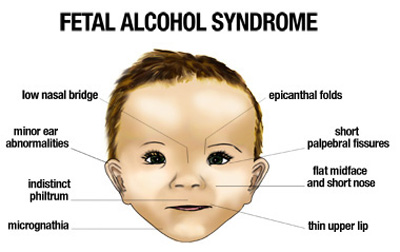In light of the Centers for Disease Control's very broad statements about alcohol use in women, perhaps this topic is somewhat appropriate. Like I alluded to in my article on embryology, there are many ocular findings associated with fetal alcohol syndrome, which are important to know, both for clinical recognition, and also for ongoing monitoring. For further reference, the CDC has a pretty useful web portal on fetal alcohol spectrum disorders.
Facial signs in fetal alcohol syndrome.
Image credit: The National Institutes of Health.
Pathogenesis
There is no question alcohol affects embryologic development in some very profound and potentially devastating ways. While the timing of alcohol consumption and concentration of alcohol necessary to induce such problems remains uncertain, we do know that, specifically to the eye, alcohol affects the formation of early ocular structures, affecting development as early as 2 weeks of gestational age (1).
Alcohol also impairs neural crest migration, and on a global aspect slows down or arrests cell differentiation and growth (2).
Ocular Manifestations
The ocular manifestations of fetal alcohol syndrome are well-recognized and may include the following:
- Optic nerve hypoplasia (nearly universal in people with FAS!)
- Epicanthal folds
- Telecanthus
- Strabismus
- Ptosis
- Microphthalmos and/or microcornea
- Peters anomaly
- Colobomas
- Persistent fetal vasculature
- Glaucoma
- Microspherophakia
Practice Questions (Answers Below)
- Which of the following findings is NOT typically found in fetal alcohol syndrome?
A. Telecanthus
B. Optic nerve hypoplasia
C. Nanophthalmos
D. Strabismus
- What statement about fetal alcohol syndrome is TRUE?
A. Midline abnormalities may occur as a result of the failure of the embryonic fissure to close.
B. Optic nerve hypoplasia results from a combination of premature apoptosis and fewer glial cells.
C. Strabismus may occur as a result of alcohol's effect on the embryo before gastrulation.
D. Foveal hypoplasia results from a failure of neural crest cells to migrate.
References and Additional Reading
- Basic and Clinical Science Course, Section 2: Fundamentals and Principles of Ophthalmology. American Academy of Ophthalmology, 2017-2018 edition.
- O'Neil E. Effects of Prenatal Alcohol Exposure on Ocular Development. The Embryo Project Encyclopedia, Arizona State University. Website.
- Basic and Clinical Science Course, Section 6: Pediatric Ophthalmology and Strabismus. American Academy of Ophthalmology, 2017-2018 edition.
Practice Question Answers
- C. Microphthalmos, microcornea, and microspherophakia may occur in fetal alcohol syndrome. One of alcohol's primary effects on the embryo is an overall failure of cells to differentiate - as a result, structures are more disorganized and less functional. Telecanthus (increased distance between both eyes) is a common facial feature and is a result of a disruption in the development of the midline structures between gastrulation (differentiation of the embryonic cells into ectoderm, mesoderm, and endoderm) and neurulation (formation of the neural tube) at approximately 2 weeks gestational age. Strabismus may occur during this stage of embryonic development as well. Optic nerve hypoplasia is one of the most common and nearly universal ocular findings in FAS and occurs as a result of premature apoptosis and a degeneration of glial cells. Nanophthalmos is a small organized globe and is associated with mutations on chromosome 11 (when inherited autosomal dominant) or in the "membrane frizzled protein" (when inherited autosomal recessive).
- B. Midline facial abnormalities occur inbetween the gastrulation phase and the neurulation phase (see #1). Likewise, strabismus in FAS may result from arrested development after gastrulation and before neurulation. Foveal hypoplasia occurs in FAS due to a reduction in cellular differentiation. Optic nerve hypoplasia is one of the most common and nearly universal ocular findings in FAS and occurs as a result of premature apoptosis and degeneration of glial cells.
Do you have any other hints to help remember important facts about fetal alcohol syndrome? Did we leave anything out? Do you have suggestions or ideas for other topics? Leave a comment or contact us!

